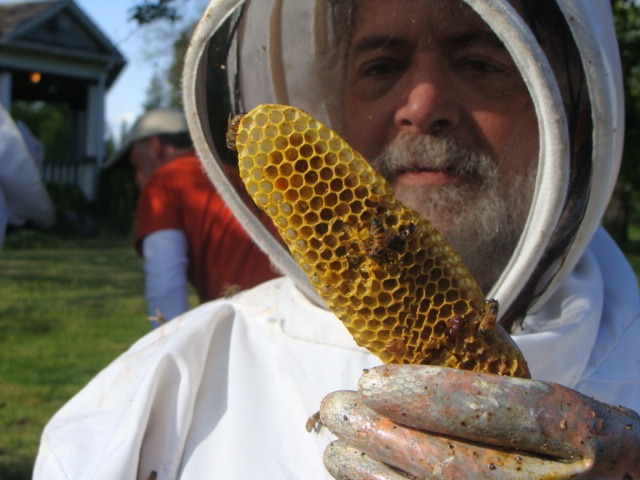Jerri Johnson walks right up to the hives, abuzz with hundreds of thousands of bees. No mask. No gloves. No bee suit. And he’s as calm as can be.
“We’re in harmony,” says Johnson, who keeps four hives in his sprawling Snoqualmie garden. “I would never be a threat to them. They’re not a threat to me. I can get just as close as I want.”
Like any beekeeper, Johnson occasionally gets stung. The last time was a few hours ago. It didn’t faze him, and he approaches one busy hive without mask or gloves to make a point: that these wild bees are pretty cool.
Next to two standard honeybee hives, some darker, mellower bees are doing their thing inside a brightly-painted stack of boxes.
A couple months ago, Johnson and fellow members of the Snoqualmie Valley Beekeepers captured this colony from a locust tree in Carnation. Since then, the queen died, but a new one is at work, and the hive has grown to about 50,000 bees.
“That’s really exciting,” says Johnson.
He prudently dons a bee suit and gloves when he opens up their hive to check on things. Johnson inspects the frames to see how the colony is doing, and decides to move some of them down in the apiary. Frames with brood, or baby bees, should be more toward the center of the box, where it’s warmer.
They don’t seem to make a fuss as Johnson carefully levers out their combs, then transfers the frames, hundreds of bees coating each one. Certainly, they aren’t swarming or defending themselves.
Johnson is not harvesting honey now, or at any time this year, from this hive.
“My goal is to make sure they make it through the winter. So, any honey they make, they keep,” he said. “Next year, we’ll see.”
The bee tree
Rewind three months. On a Tuesday afternoon in April, four members of the Snoqualmie Valley Beekeepers club converged on a locust tree near Carnation. This was a special tree—a “bee tree.”
The locust was home to a wild hive. Honeybees were introduced to this continent by European settlers, but bees don’t always stay home on the farm. Feral hives are common, and this group, 35,000 strong, had no owner. The nearest residents, property owners Josh and Jean Courtney, weren’t comfortable with their bee neighbors, because Josh is very allergic to stings. So, he asked for help from local beekeepers.
After checking out the hive for several months, Johnson enlisted fellow beekeepers Ben Session, Ron Johnson and Jim Ullman.
At the scene, they suited up in protective clothing, got a smoker and other equipment ready. Then Johnson fired up his chainsaw, and the cutting began. Smoke is used to trick the bees into thinking a forest fire is near. Instead of focusing on intruders, they gorge themselves on honey and prepare to flee. The smoke also masks alarm pheromones from guard bees.
Johnson related that these bees were so gentle, it turned out that the smoker was not needed.
He and Session started extracting the brood combs, with the young bees attached. Ron and Ullman used a special vacuum to capture the adult bees.
Neighbors watched as the team finished their work and sealed up the tree.
The bees were taken to Johnson’s farm in Snoqualmie.
Johnson went back the next day, gathering another 20,000 bees, reuniting them with the first batch, about 15,000.
After a few days of housecleaning, all the bees settled down to their new life.
Now, Johnson is doing his best to give them all the advantages they need to survive.
The future of honeybees depends on people. Johnson is saddened when he visits big hardware chains and sees huge pesticide aisles next to a few feet of organic products. Any spray that hits a plant with flowers, he explains, will eventually mean poison is carried back home to the hive. He scrupulously avoids poisonous chemicals at his own garden.
Johnson has kept bees for three years. He doesn’t do this for honey, or for the fact that these insects may pollinate his big garden during their flights over a three-mile radius around his home.
“I’m a guardian,” Johnson says. “These are an endangered species. It’s my little way of keeping the planet alive.”
• You can learn more about the association at www.snoqualmievalleybeekeepers.org.
Bee lovers
Snoqualmie Valley Beekeepers is a non-profit organization in the Snoqualmie Valley, primarily serving the communities of North Bend, Snoqualmie, Fall City, Carnation, Duvall, and the greater Eastside.
Club membership is $20 per year for a family. Club meetings are open to the public.
The club holds regular classes and special events on beekeeping techniques, the latest science, and get-togethers.

Above, beekeepers Ben Session, Ron Johnson, Jerri Johnson and Jim Ullman cut a wild beehive out of a Carnation tree. One of the homeowners was badly allergic to bees.

A view of the wild beehive, which bees made in the interior of the locust tree.

Above, Jim Ullman shows children some bee brood, or baby bees, found in the wild hive.

Jerri Johnson with the new hive, home to his newly found wild bees. Below, Johnson with one of the salvaged combs.


A group shot at the bee colony capture.


